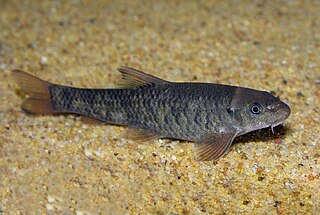
Barbus is a genus of ray-finned fish in the family Cyprinidae. The type species of Barbus is the common barbel, first described as Cyprinus barbus and now named Barbus barbus. Barbus is the namesake genus of the subfamily Barbinae, but given their relationships, that taxon is better included in the Cyprininae at least for the largest part.

The red garra, also known as the doctor fish or nibble fish, is a species of cyprinid that is native to a wide range of freshwater habitats in subtropical parts of Western Asia. This small fish typically is up to about 14 centimeters in total length, but locally individuals can reach as much as 24 cm (9.5 in).

Alburnoides is a genus of cyprinid fishes native to Europe and Asia. Many species are known as riffle minnows or spirlins.

Alburnus is a genus of fish in the family Cyprinidae, the carps and minnows. They are known commonly as bleaks. A group of species in the genus is known as shemayas. The genus occurs in the western Palearctic realm, and the center of diversity is in Turkey.

Capoeta, also known as scrapers, is a genus of fish in the family Cyprinidae found in Western Asia. The distribution extends from Turkey to the Levant, to Transcaucasia, Iraq, Turkmenistan, in Armenia, particularly in lake Sevan and northern Afghanistan. This genus is most closely related to Luciobarbus and in itself is divided into three morphologically, biogeographically and genetically distinct groups or clades: the Mesopotamian clade, the Anatolian-Iranian clade and the Aralo-Caspian clade. The Mesopotamian clade was split off to Paracapoeta in 2022.

Cobitis is a genus of small freshwater fish in the family Cobitidae from temperate and subtropical Eurasia. It contains the "typical spiny loaches", including the well-known spined loach of Europe. Similar spiny loaches, occurring generally south of the range of Cobitis, are nowadays separated in Sabanejewia.

Garra is a genus of fish in the family Cyprinidae. These fish are one example of the "log suckers", sucker-mouthed barbs and other cyprinids commonly kept in aquaria to keep down algae. The doctor fish of Anatolia and the Middle East belongs in this genus. The majority of the more than 160 species of garras are native to Asia, but about one-fifth of the species are from Africa.

Gobio is a genus of typical gudgeons, ray-finned fish in the family Cyprinidae many of which are endemics of south-eastern Europe. Members of the genus are usually small fish, rarely longer than 10 cm.
Seminemacheilus is a genus of stone loaches native to western Asia with species known from Turkey and Iran.
Squalius is a genus of fish in the family Cyprinidae found in Europe and Asia. Hybridization is not rare in the Cyprinidae, including this genus. S. alburnoides is known to be of ancient hybrid origin, with the paternal lineage deriving from a prehistoric species related to Anaecypris; the latter mated with ancestral S. pyrenaicus. Present-day S. alburnoides mates with sympatric congeners of other species.
Maurice Kottelat is a Swiss ichthyologist specializing in Eurasian freshwater fishes.
Oxynoemacheilus frenatus, the banded Tigris loach, is a species of ray-finned fish in the genus Oxynoemacheilus. This species is widespread in the upper drainage basin of the Tigris in Turkey, Syria and Iraq where it can be locally very common. It can be found in habitats varying from streams with a moderately fast current to near standing waters in springs, streams and rivers which have beds of gravel or mud. Academically speaking, it inhabits fast-flowing streams and rivers with rocky substrates.
Oxynoemacheilus longipinnis is a species of loach in the family Nemacheilidae endemic to the Meymeh River, formerly a part of the Tigris-Euphrates system in Iran. Fishbase lists it as the only species in the monotypic genus Ilamnemacheilus.
Paracobitis is a genus of Asian stone loaches.
Paraschistura is a genus of stone loaches most of which occur in Central, South and Western Asia.

Turcinoemacheilus is a genus of loaches in family Nemacheilidae native to Asia.

The Nemacheilidae, or stone loaches, are a family of cypriniform fishes that inhabit stream environments, mostly in Eurasia, with one genus, Afronemacheilus found in Africa. The family includes about 790 species.
The Western crested loach, Paracobitis malapterura is a species of stone loach endemic to the Tigris–Euphrates river system. This species reaches a length of 12.6 cm (5.0 in).

Paracapoeta is a genus of fish in the family Cyprinidae found in Mesopotamia, Cilicia and the Levant, Western Asia. This genus is closely related to Luciobarbus and was formerly the Mesopotamian clade of Capoeta before being split off in 2022. The generic name alludes to παρά meaning "near" and Capoeta.










